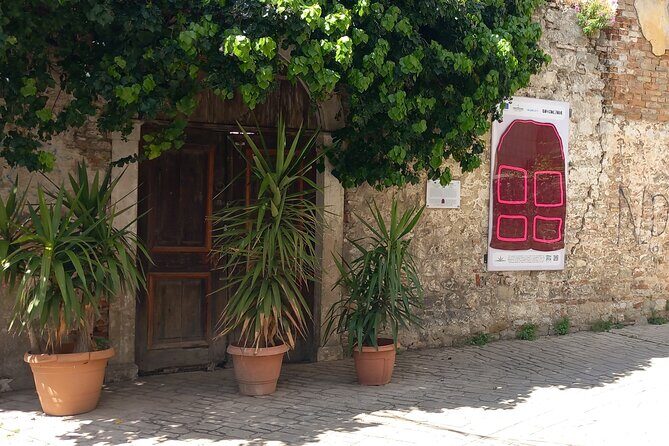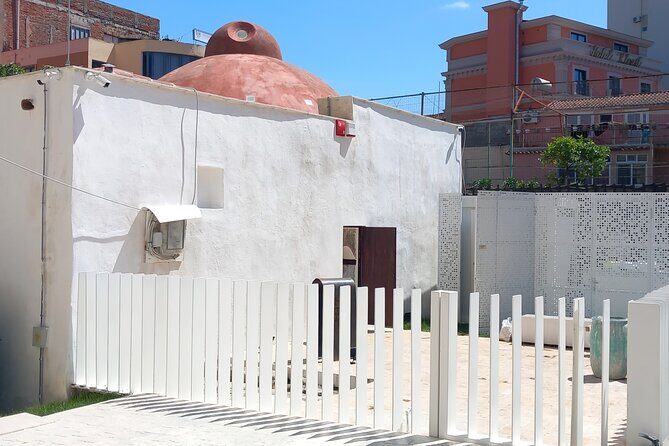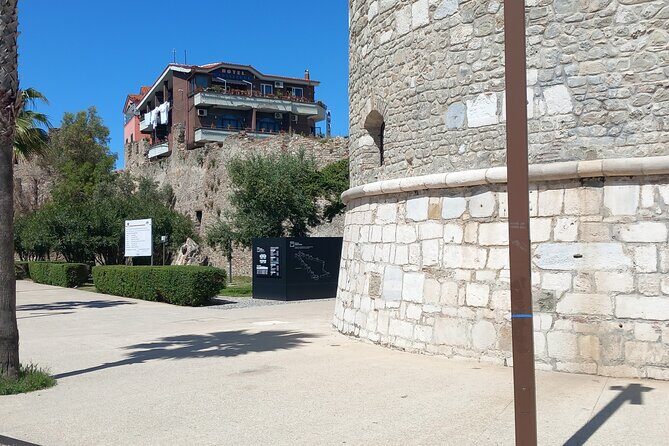A Guided Walk through Durrës: Exploring Albania’s Coastal Treasure
This private walking tour of Durrës, led by a licensed guide, lasts about 2 to 3 hours and costs around $35.57 per person. It’s perfect for travelers who want more than just a sightseeing checklist — you’ll walk through the city’s streets, uncovering layers of history, architecture, and social change that shaped this ancient port town. The tour begins at the Venetian Tower, and over the course of the walk, you’ll visit historic sites such as the Roman amphitheater, Ottoman hamam, and Fatih Mosque, as well as modern landmarks like the City Hall and theatre.
What I love about this experience is the way it combines storytelling with visual discovery. We appreciated how the guide, Artan, explains each site’s significance not only through facts but also by weaving in social and political stories that bring Durrës to life. Plus, the fact that it’s a private tour means you can ask questions freely and get a tailored experience, which feels much richer than a group tour.
However, one consideration is that some sites, like the Venetian Tower’s multimedia projection, require an extra fee for access to certain features. It’s worth budgeting for that if you’re keen to see everything. Also, given the variety of sites visited, comfortable shoes and an open mind about walking are essential.
This tour suits history buffs, architecture lovers, and curious travelers who want to understand Durrës beyond surface-level sights. If you’re interested in how the city has changed through centuries and enjoy insightful conversations, this tour will hit the right note.
Key Points

- In-Depth Historical Context: The guide weaves stories about Durrës’ layers of occupation, from ancient Rome to Ottoman and modern Albania.
- Authentic Local Sites: You’ll visit significant landmarks like the Roman amphitheater, Fatih Mosque, and Ottoman hamam.
- Balanced Mix of Past & Present: The tour discusses the city’s growth from antiquity to today’s urban development, including recent renovations.
- Flexible and Private: With only your group, questions are encouraged, making the experience more personal and adaptable.
- Cost-Effective: At just over $35, you gain a comprehensive, engaging introduction to Durrës without overspending.
- Educational Resources: You receive a list of international bibliographic references to deepen your understanding after the tour.
Exploring Durrës: An In-Depth Review
If you’re planning to visit Albania and want to explore its coastal charm with a knowledgeable guide, this private walk through Durrës offers a compelling way to connect with the city’s history and contemporary life. The tour, priced at $35.57 per person, is designed for small groups or individuals seeking a personalized experience. Lasting around 2 to 3 hours, it covers a wide range of sites, from ancient ruins to modern civic buildings.
Start at the Venetian Tower, one of Durrës’ most iconic landmarks. You’ll appreciate the explanation of its construction techniques and its historical role during Ottoman rule. The guide emphasizes that the tower is not just a relic; it’s a symbol of the city’s layered history. For those interested in architecture and military history, this stop offers insights into different building styles and strategic uses across centuries. You’ll also hear about recent renovations funded by the European Commission, transforming this site into a multimedia center — perfect for understanding how history is preserved and presented today.
Next, the tour moves to the Roman amphitheater — a highlight for history enthusiasts. Discovered in 1966, it is a rare glimpse into Durrës’ ancient past. Our guide explained how the amphitheater’s excavation revealed secrets about Roman entertainment and urban planning. We loved the way artifacts and the site itself showcased how the city evolved from Roman times through subsequent ages. The restoration efforts aim to highlight these historical layers, making it a must-see for anyone curious about Albania’s ancient legacy.
The Church of Saint Paul and Saint Astius introduces a quieter spiritual dimension. It’s a modest church that hints at the city’s religious diversity and historical shifts, especially considering the traces of the now-demolished Saint Spiridon church. The guide’s stories about local saints and the church’s history make this more than just a building — it feels like a connection to the community’s spiritual roots.
Crossing into the Ottoman period, the Ottoman Hamam offers a fascinating peek into 17th-century bathing culture. Built in the 1600s, the structure shows how public baths were both functional and social spaces. Visitors can see remains of old roads leading to Durres Castle, giving a sense of the city’s layout and everyday life in Ottoman times. The explanation of steam and heating techniques makes you appreciate the ingenuity of historical architecture, even if the interior isn’t open for viewing.
Walking along Bulevardi Epidamn, you’ll admire early 20th-century architecture and urban planning. The street’s buildings reflect the investment and modernization efforts of the 1928 urban plan. We enjoyed the pause here for refreshments — you might want to try local burek or sip on fresh orange juice, adding a taste of local flavor to the walk. This segment offers a relaxed chance to observe how the new city took shape amid historical shifts.
The Aleksandër Moisiu Museum provides a cultural touchstone, showcasing the city’s connection to its famous theater artist. The house, once the English consulate, stands damaged but still tells stories of international ties and local talent. It’s a reminder of the resilience of cultural institutions, even after earthquake damages in 2019.
At the Fatih Mosque, built in 1501, we gain insight into Islamic architecture’s adaptation within a Christian city. Its construction using Byzantine materials illustrates how religions and empires layered their influence here. The mosque’s position, partly concealed by Byzantine walls, hints at the complex history of religious coexistence.
The Durres Amphitheatre remains a highlight, especially given its proximity to the city center. The excavation and restoration projects reveal new insights into Roman entertainment and urban life. Our guide explained the site’s potential as a cultural and tourism magnet, making it a crucial part of Durrës’ identity.
Walking into the Catholic Church of Saint Lucy, we get a glimpse of religious diversity and history. Its condition today reflects the challenges faced during the communist era, when religious activities were suppressed. The story of its construction and recent restoration adds depth to understanding Durrës’ multicultural fabric.
The Town Square (Sheshi Liria), originally a floral garden in 1928, now hosts the municipality and the Grand Mosque. Walking here, you’ll see how Ottoman, Italian, and Albanian influences combined to shape public spaces. The guide points out how the square’s development mirrors the city’s broader urban and social evolution.
The Municipality building, constructed in 1931 with Italian aesthetics, offers a glimpse into early 20th-century civic architecture. The large public clock and the building’s central role in city governance make it a landmark worth noting. It exemplifies how architecture can serve civic pride and community identity.
Next, the Xhamia E Madhe, built in 1939, symbolizes Durres’ Muslim community resilience. Its history of closures under regime changes and restoration after 1990 reflect the city’s ongoing cultural and religious renewal. Visiting this mosque offers a meaningful look at how faith persists through political upheaval.
The “Aleksandër Moisiu” Theatre, from 1960, is more than just a performance venue — it’s a symbol of Albanian cultural identity. Our guide explained the architectural style of the era, which helps you see how national identity was expressed through public buildings during the communist period.
Finally, the Byzantine Forum uncovered by archaeologist Vangjel Toci completes the journey. This site connects the city’s Late Antiquity origins with the Middle Ages. Artifacts displayed here provide a tangible link to the city’s vibrant Byzantine past.
Prefer personalized experiences? Here are other private options we've covered in Tirana
Who Should Take This Tour?

This walk is ideal for those who love history, architecture, and stories that connect the dots between past and present. It’s especially suitable if you enjoy engaging guides and want to see a city’s layers through its buildings and streets. The tour’s private nature makes it adaptable for different interests, whether you want a thorough historical explanation or a casual stroll with local flavor.
While it involves some walking and site entry, the pace is manageable, and the stops are well spaced. The tour provides a well-rounded introduction to Durrës, helping you appreciate its significance as Albania’s oldest port city and a living museum of history.
FAQ

Is this tour suitable for all ages?
Yes, as it involves walking and sight visits, it’s suitable for most ages. Just be prepared for some walking and consider comfortable shoes.
Does the tour include entrance fees?
Most of the sites are free to view, but certain features, like the multimedia projection in the Venetian Tower, require an additional fee, which is not included in the tour price.
How long does the tour last?
The tour lasts approximately 2 to 3 hours, depending on group pace and questions.
Is the tour private or group-based?
It’s a private experience, meaning only your group will participate, providing a more personalized and flexible experience.
What should I bring?
Bring comfortable walking shoes, water, and maybe a notebook if you want to jot down interesting facts or references provided.
Is the tour accessible for travelers with mobility issues?
Since it involves walking and site visits, it may not be fully accessible for those with mobility challenges. Check with the provider if needed.
Do I need to book in advance?
Yes, booking ahead guarantees your spot, especially since it’s a private tour. Confirmations are immediate upon booking.
Can I customize the tour?
Given the private nature, you can ask the guide questions or focus on specific sites of interest within the itinerary.
What is the best time of day to take this tour?
Morning or late afternoon is ideal to avoid the midday heat and enjoy a relaxed walk.
To sum it up, this private walking tour of Durrës offers a thorough, engaging, and affordable way to uncover the city’s many layers. It balances archaeological wonders, religious sites, and modern architecture, making it perfect for travelers who want more than just a checklist. The knowledgeable guide, Artan, makes history come alive, helping you see Durrës as a city shaped by centuries of cultural influences. Whether you’re a history buff or simply curious about Albania’s coastal gem, this tour provides meaningful insights wrapped in a friendly, personal experience.
More Walking Tours in Tirana
More Tours in Tirana
- From Tirana and Durres, Kruja Old Bazaar and Castle Day Tour
- Small Group Hiking Tour of Theth & Blue Eye in 2 Days
- City and Food Tour of Tirana
- Small Group Tour of Albanian Riviera; Saranda, Ksamil & Dhermi
- Durres Countryside Vineyards Wine & Food Tasting Tour
- Private 2 day Tour of Kosovo and North Macedonia from Tirana
If you're drawn to exploring Tirana on foot, we've looked into these other walking experiences
More Tour Reviews in Tirana
More Tirana experiences we've covered
- From Tirana and Durres, Kruja Old Bazaar and Castle Day Tour
- Discover the Best of Albania: 7 Days of Highlights & Hidden Gems
- Small Group Hiking Tour of Theth & Blue Eye in 2 Days
- Transfers Airport – Tirana
- Wine Tasting & Vineyards Escape near Tirana
- City and Food Tour of Tirana
- Small Group Tour of Albanian Riviera; Saranda, Ksamil & Dhermi
- Durres Countryside Vineyards Wine & Food Tasting Tour
- Private 2 day Tour of Kosovo and North Macedonia from Tirana
- Pub Crawl Tirana
- Berat Osum Canyon & Bogove Waterfall Tour
- Small Group Tour; Pearls of Albania in 8 Days (3 UNESCO Sites)
